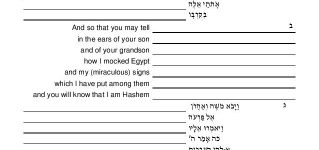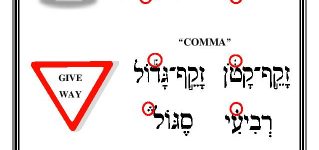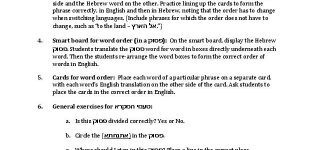Syntax (Sentence Structure)
The student will be able to construct the meaning of the פסוק based on analyzing its parts, including word combination, word order and dividing a פסוק into phrases.
| Enduring Understandings |
|---|
| 1. The sentence structure of לה”ק is different from the sentence structure of English. |
| 2. תורה comes with a set of rules for punctuation and sentence structure in the form of טעמי המקרא, which are הלכה למשה מסיני. |
| 3. Just like words serve particular functions, such as nouns (naming words) and verbs (action words), different parts of a פסוק or sentence provide different kinds of information (subject, action, description, etc.). |
| Essential Questions |
|---|
| 1. How would this פסוק or phrase be written differently if it were in English? |
| 2. What do the טעמי המקרא tell us about how to organize and understand this פסוק? |
| 3. What is this part of the פסוק doing/telling us? |
Key Knowledge:
- פסוקים in לה”ק cannot be translated word for word into English without changing the order of the words.
- In order to translate the פסוקים into meaningful sentences, the words need to be grouped into two and three word unit and translated for meaning rather than individually and literally. For example, ויאמר ה’ אל משה means “Hashem said to Moshe,” and not “he said Hashem to Moshe.”
- Nouns, verbs and adjectives are all conjugated differently from one another in לשון הקדש. (Prefixes and suffixes change depending on whether the word is a noun or verb.)
- A פסוק may or may not be a complete sentence. (Some פסוקים are dependent clauses reliant on previous פסוקים).
- A פסוק may contain one or more ‘English’ sentences.
- The simplest Hebrew sentence comprises of a noun and a verb or an adjective.
- The person doing the action or the person or item being described in a sentence is called the subject. “Who” is doing the action or “Who or what” is this talking about?
- The person or thing that receives the action (verb) is the direct object of the sentence.
- The indirect object identifies to whom or for whom, the action of the verb is performed. E.g: “ויעקב נתן לעשו לחם ונזיד עדשים”. – Yaakov is the subject, the food (לחם ונזיד עדשים) is the object – Yaakov gave food; עשו is the indirect object – he is the one to whom the food was given.
The rest of the sentence will give us additional information like where, when, why or how something was done.
3.08 Grouping and Word Order
B. Changes word order appropriately when translating phrases in learned פסוקים.
B. Changes word order appropriately when translating phrases in learned פסוקים.
B. Changes word order appropriately when translating a פסוק for which literal translation is provided but grouping into phrases is not, identifying when word order is different than in English.
B. Changes word order appropriately when translating a פסוק for which literal translation is provided but grouping into phrases is not, identifying when word order is different than in English.
B. Changes word order appropriately when translating an unlearned פסוק, identifying when word order is different than in English.
B. Changes word order appropriately when translating an unlearned פסוק, identifying when word order is different than in English.
B. Changes word order appropriately when translating an unlearned פסוק, identifying when word order is different than in English.
B. Changes word order appropriately when translating an unlearned פסוק, identifying when word order is different than in English.
Grades 3-4: Groups the פסוק into phrases (of two or three words), when translating a פסוק for which literal translation is provided but grouping into phrases is not.
Grades 5-8: Groups the פסוק into phrases when translating an unlearned פסוק, according to the rules of סמיכות (see nouns) and context.
Grades 3-4: Changes word order appropriately when translating a פסוק for which literal translation is provided but grouping into phrases is not, identifying when word order is different than in English.
Grades 5-8: Changes word order appropriately when translating an unlearned פסוק, identifying when word order is different than in English.
Resources
3.09 Parsing the פסוק
Grades 3-4: Identifies the זקף קטן, זקף גדול, סגול, רביעי, and their roles, in addition to the אתנחתא and סוף פסוק, and their roles and reads, translates and punctuates the פסוק accordingly.
Grades 5-8: Identifies מרכא-טפחא, קדמא-אזלא and the תביר-טפחא as indicating words that should not be separated for translation, and reads, translates and punctuates the פסוק accordingly in addition to being able to divide the פסוק based on the טעמי המקרא learned in previous years.



